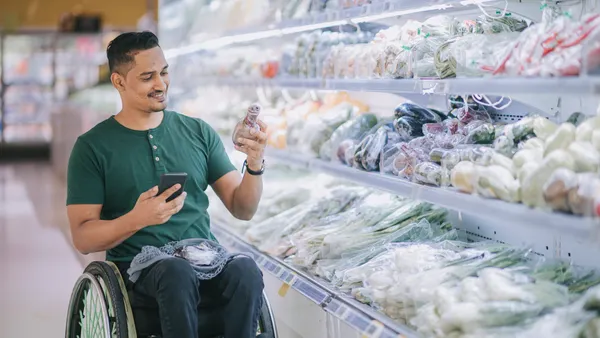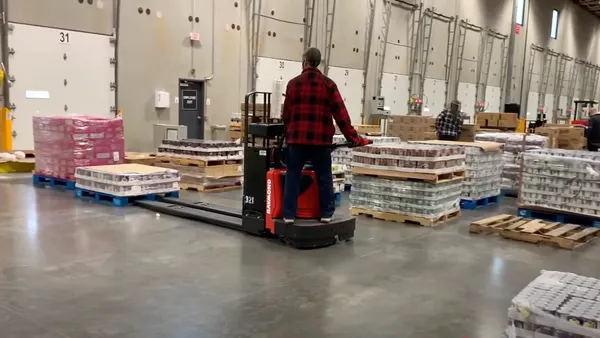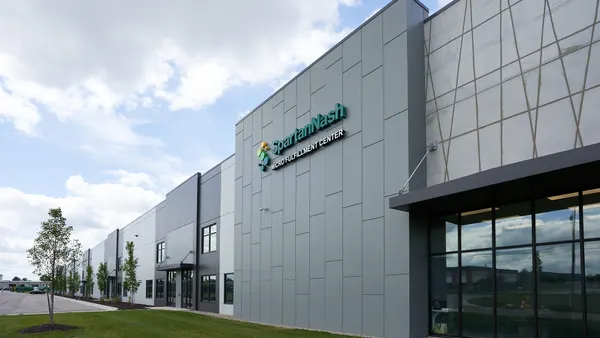Dive Brief:
- Kroger reported net sales of $27.67 billion for the third quarter, an expected .3% decrease over the same period a year ago due to fuel costs, the sale of its convenience-store unit and the acquisition of meal kit company Home Chef. Same-store sales increased 1.6%, slightly off from the 1.7% anticipated by Wall Street. Company shares dipped just under 2% in early trading.
- Net income for the company dropped $80 million from Q3 last year to $317 million, or 39 cents a share, due primarily to rising investments in alternative revenue streams. Kroger's gross margins fell 91 basis points to 21.6% of sales, mostly due to price investments, rising transportation costs and the growth of the company's low-margin specialty pharmacy business.
- Kroger's digital sales were up 60% for the quarter while private label sales once again set quarterly records for unit and dollar sales share — 28.7% and 26.6%, respectively. "Kroger is transforming our business model," CEO Rodney McMullen said in a statement. "We're moving from a traditional grocer to a growth company with both a strong customer ecosystem that offers anything, anytime, anywhere, and asset-light, high-margin alternative partnerships and services. Restock Kroger is the blueprint for this transformation."
Dive Insight:
Kroger has rolled out several eye-catching initiatives this year, but those initiatives continue to cut into profitability as the grocer seeks to balance future growth with the current realities of its business.
Despite posting earnings that were mostly in line with Wall Street estimates, the company's stock dipped slightly in early trading. Rising competition has taken a significant toll on Kroger. In addition to future-focused investments in e-commerce and new formats, the company is spending a lot on pricing and updates to its assortment. Using its leading data science, Kroger is on track to optimize assortments at 600 stores this year — a "massive undertaking" that also disrupts sales, Chief Financial Officer Mike Schlotman noted during the company’s earnings call this morning, but one that’s necessary for growth.
Analysts noted the results continue to show the significant pressure Kroger is under right now as competition tightens and consumer preferences evolve.
“Kroger’s third quarter results demonstrate that price investments continue to pressure gross margins while benefiting top line growth," Moody’s Vice President Mickey Chadha stated in a note emailed to Grocery Dive.
However, Kroger wants its company narrative to center on innovation and future opportunities rather than near-term pressures. To that end, this quarter the company expanded its direct-to-consumer marketplace, Kroger Ship, to all of its operating markets. It also rolled out its new fashion line, Dip, to 300 stores and introduced a Geoffrey's Toy Box, a special display in partnership with the recently bankrupt Toys R Us, in 600 stores. The company's personal finance service saw record profits as did its recently introduced digital marketing service, which saw a 150% gain in profitability.
This week, Kroger began placing mini grocery outlets inside Walgreens stores — a move that could effectively increase the grocer's footprint without requiring spending on new stores.
Future-focused investments like this one are promising, but they remain bets all the same. Will they pan out over the long term? Some industry observers are bullish, some not so much. Regardless, analysts see the alternative investments as necessary for the under-fire grocer.
“Overall, the results are far from fantastic and continue to show pressure on top line growth and a significant drag on the bottom line,” wrote Neil Saunders, managing director of GlobalData Retail, in a note emailed to Grocery Dive. “That said, the company is innovative and is putting in place a number of plays — from digital solutions to meal kits — that will allow it to generate some market share growth over the medium term.”
Despite digital growth of 60% and an online shopping footprint that now reaches 90% of its customers, Kroger’s e-commerce push also remains a question mark in terms of profitability. That’s because competitors like Walmart, Amazon and Target are also investing deeply in online shopping and seeing stellar results. Kroger hopes its roll-out of automated Ocado warehouses will save on fulfillment costs and help the company acquire more shoppers through lower prices. But the first warehouse, which will go up in Marion, Ohio, is still two years from coming online. It’s unclear whether Kroger’s hefty investment will deliver increased profitability or whether it will become yet another cost of doing business.
Kroger is still in the first year of its Restock turnaround initiative. If its alternative investments begin to pay off and strengths like its private label business continue to grow, the company will be well-positioned to fulfill its goal of standing tall amidst pressure from Walmart, Amazon and company. If its many initiatives fail to hit pay dirt though, Kroger will find itself scrambling to keep up in the fast-changing industry. The stakes couldn't be higher for the nation's largest supermarket chain.











